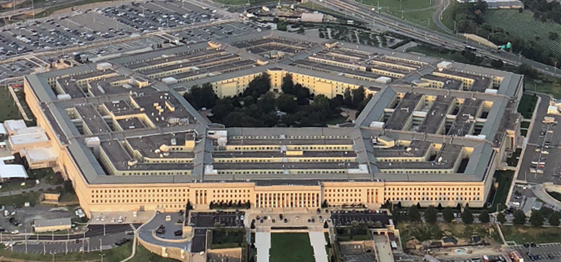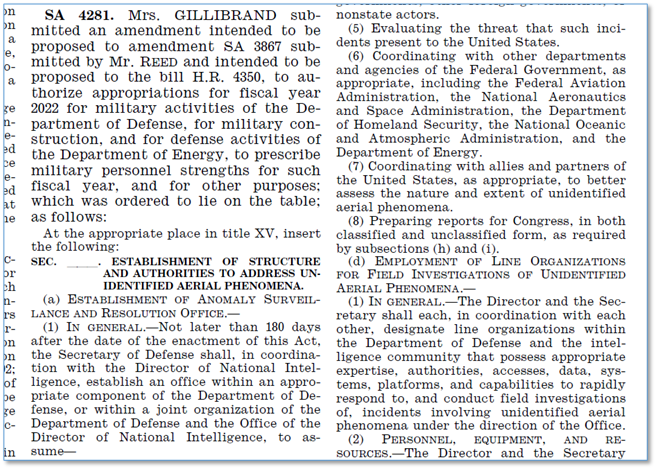
Aerial view of the the Pentagon building, headquarters of the US Department of Defense (from Wikipedia)
Preface
The context
At the military level, the process is being driven by the US Navy.

The video called 'Gimbal' in the Youtube channel of To The Stars Academy (from youtube.com)
The law envisages the replacement of the UAPTF by a permanent high-level office with cross-department competences to be created within the Office of the Minister of Defense, and establishes for it a series of duties. These duties are mainly aimed at the implementation of measures for the standardization and rationalization of the processing, circulation and analysis of information pertaining to UAP/UFO within the Department. There are also provisions for the monitoring and analysis of possible threats posed by state and non-state actors. In an unprecedented move, the rules also provide that the new office will interface with friendly and partner countries "for the purpose of better assessing the threat posed by UAPs".
The law also envisages reporting duties, including unclassified reporting, by the Pentagon to Congress on a wide range of activities (essentially statistical, risk assessment, and analytical). Within this range of activities there are a couple of firsts: the request for "an update on ongoing activities to capture or exploit unidentified aerial phenomena encountered" and "The assessment of health effects for individuals who have encountered unidentified aerial phenomena."

The amendment to NDAA22 introduced by Senator Kerstin Gillibrand. (from https://www.congress.gov)
The amendment provides specific rules for field investigations, the most important of which are the ability of the director of the new office to use entities within DoD and the intelligence community for this purpose, as well as other entities, even non-military, to analyze the results obtained from field investigations.
There are provisions for acquiring as much data as possible on UAPs through intelligence tools and the related acquisition plans.
Provision is made for the office to operate on the basis of a precise scientific plan for the purpose of formulating theories that can shed light on the functioning of UAPs.
Provisions are also made for financing the operations of the new office.
Finally, there is provision for extensive information to be provided to Congress in unclassified form, but with the possibility of a classified attachment. Detailed information on a wide range of aspects pertaining to UAP phenomenology, with the addition (with respect to the original text of the law) of specific information on UAP events related to nuclear facilities are required.
In addition to the above information, the amendment introduces the provision for special classified briefings on a semi-annual basis to the Congressional Defense and Intelligence Committees.
But perhaps the biggest change introduced by the amendment with respect to the original text of the bill is the creation of the Airborne and Transmedia Phenomena Advisory Committee (ATPAC). The Committee will be composed of a maximum of 20+5 people who will have the task of advising the new office and its director in carrying out the activities of the institute.
Important to note here is the composition of this committee, which includes not only personnel from various U.S. government civil agencies and research organizations but, and this is a real new-one, also from private research organizationssuch as the Scientific Coalition for Unidentified Aerospace Phenomena Studies (SCU).
Provision is also made that in addition to the basic twenty people, the Committee may also include up to five additional people at the discretion of the Director, at least three of whom must not be employees of the federal government.

Senator Kerstin Gillibrand (da Wikipedia)
The Pentagon's move
But perhaps the most significant aspects are first of all that the task list of the new office does not include any congressional briefing activities by the Pentagon and that the new office will be composed exclusively military personnel.
The document specifies that the new office will deal with UAPs for the purpose of minimizing risks to aviation safety and national security, and there is no mention of the UAP-nuclear connection, let alone of scientific research activities on UAPs.
Finally, the Memorandum of Establishment of AOIMSG does not include any detailed provision on the set-up of the new office and its funding, referring for these aspects to subsequent provisions to be formulated and proposed by its Interim Director.
General comment
Summing up
Viewed from the military perspective, one can indeed understand how the Congressional initiative would deprive the military and intelligence establishment of the power and control over the UFO issue that they have always maintained.
Of course, the secrecy that has always been imposed on the UFO/UAP phenomenon does not allow us to know if there are really such important elements in it that make it a tasty morsel for the military to hold in its teeth, but if an entity like the Pentagon has acted in this way it is logical to assume that in the UFO/UAP issue there is indeed something very important , so important that they do not want to lose control of.
Finally, reasoning from the point of view of the ufological researcher well aware of the historical events, it is difficult to avoid believing that the Pentagon's move was motivated only by the desire to maintain control over the UFO issue. While not defining himself as a conspiracy buff, this writer cannot help but imagine that in the more than seventy years of constant mystification, deception, repression and ignorance about UFOs/UAPs consciously implemented by the Pentagon a number of skeletons may have produced, and that the need to keep them locked in the proverbial lockers still continues.
Conclusion
_____________________________
